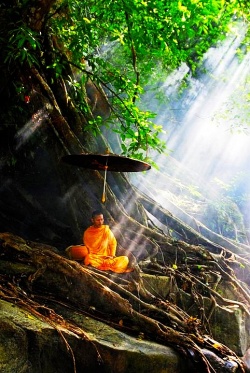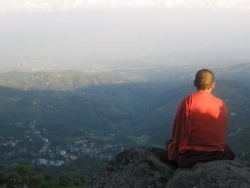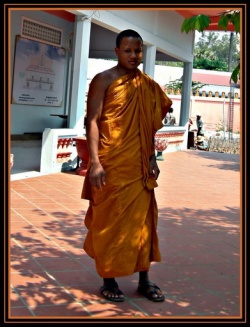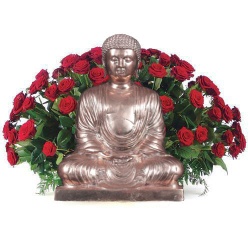Buddhism in Sri Lanka - A Brief History
By Barbara O'Brien,
When Buddhism spread beyond India, the first nations in which it took root were Gandhara and Ceylon, now called Sri Lanka. Since Buddhism eventually died out in India and Gandhara, it can be argued that the oldest living Buddhist tradition today is found in Sri Lanka.
Today about 70 percent of the citizens of Sri Lanka are Theravada Buddhists. This article will look at how Buddhism came to Sri Lanka, once called Ceylon; how it was challenged by European missionaries; and how it was revived.
How Buddhism Came to Ceylon
The history of Buddhism in Sri Lanka begins with the Emperor Ashoka of India (304 - 232 BCE). Ashoka the Great was a patron of Buddhism, and when King Tissa of Ceylon sent an emissary to India, Ashoka seized the opportunity to put in a good word about Buddhism to the
King.
Without waiting for a reaction from King Tissa, the Emperor sent his son Mahinda and his daughter Sanghamitta -- a monk and a nun -- to Tissa's court. Soon the King and his court were converted.
For several centuries Buddhism flourished in Ceylon. Travelers reported many thousands of monks and magnificent temples. The Pali Canon was first written in Ceylon. In the 5th century, the great Indian scholar Buddhaghosa came to Ceylon to study and write his famous
commentaries. Beginning in the 6th century, however, political instability within Ceylon combined with invasions by the Tamils of southern India caused support for Buddhism to decline.
From the 12th through 14th centuries Buddhism regained much of its former energy and influence. Then it faced its greatest challenge -- Europeans.
Mercenaries, Merchants and Missionaries
Lourenco de Almeida (died 1508), a Portuguese sea captain, landed on Ceylon in 1505 and established a port at Colombo. At the time Ceylon was divided into several warring kingdoms, and the Portuguese took advantage of the chaos to gain control of the island's coasts.
The Portuguese had no tolerance for Buddhism. They destroyed monasteries, libraries, and art. Any monk caught wearing a saffron robe was executed. According to some accounts - possibly exaggerated - when the Portuguese finally were expelled from Ceylon in 1658 only
five fully ordained monks remained.
The Portuguese were expelled by the Dutch, who took control of the island until 1795. The Dutch were more interested in commerce than in Buddhism and left the remaining monasteries alone. However, the Sinhalese discovered that under Dutch rule there were advantages to
becoming Christian; Christians had higher civil status, for example. The converted were sometimes referred to as "government Christians."
During the upheaval of the Napoleonic Wars, Britain was able to take Ceylon in 1796. Soon Christian missionaries were pouring into Ceylon. The British government encouraged Christian missions, believing Christianity would have a "civilizing" effect on the "natives."
The missionaries opened schools throughout the island to convert the people of Ceylon from their "idolatry."
By the 19th century, Buddhist institutions in Ceylon were moribund, and the people were largely ignorant of the spiritual tradition of their ancestors. Then three remarkable men turned this state of affairs on its head.
The Revival
In 1866, a charismatic young monk named Mohottivatte Gunananda (1823-1890) challenged the Christian missionaries to a great debate. Gunananda was well prepared. He had studied not only the Christian scriptures but also rationalist writings of the West that criticized
Christianity. He had already been traveling around the island nation calling for a return to Buddhism and attracting thousands of rapt listeners.
In a series of debates held in 1866, 1871, and 1873, Gunananda alone debated the foremost missionaries in Ceylon on the relative merits of their religions. To the Buddhists of Ceylon, Gunananda was the hands-down winner each time.
In 1880 Gunananda was joined by an unlikely partner -- Henry Steel Olcott (1832-1907), a New York customs lawyer who had given up his practice to seek the wisdom of the East. Olcott also traveled throughout Ceylon, sometimes in the company of Gunananda, distributing
pro-Buddhist, anti-Christian tracts. Olcott agitated for Buddhist civil rights, wrote a Buddhist Catechism still in use today, and founded several schools.
In 1883, Olcott was joined by a young Sinhalese man who had taken the name Anagarika Dharmapala. Born David Hewivitarne, Dharmapala (1864-1933) had been given a thoroughly Christian education in Ceylon's missionary schools. When he chose Buddhism over Christianity, he
took the name Dharmapala, which means "protector of the dharma," and the title Anagarika, "homeless one." He did not take full monastic vows but lived the eight Uposatha vows daily for the rest of his life.
Dharmapala joined the Theosophical Society that had been founded by Olcott and his partner, Helena Petrovna Blavatsky, and became a translator for Olcott and Blavatsky. However, the Theosophists believed all religions have a common foundation, a tenet Dharmapala
rejected, and he and the Theosophists eventually would part ways.
Dharmapala worked tirelessly to promote the study and practice of Buddhism, in Ceylon and beyond. He was particularly sensitive to the way Buddhism was being presented in the West. In 1893 he traveled to Chicago to the World Parliament of Religions and presented a
paper on Buddhism that emphasized Buddhism's harmony with science and rational thinking. Dharmapala influenced much of the West's impression of Buddhism.
After the Revival
In the 20th century the people of Ceylon gained more autonomy and eventually independence from Britain, becoming the Free Sovereign and Independent Republic of Sri Lanka in 1956. Sri Lanka has had more than its share of upheavals since. But Buddhism in Sri Lanka is as strong as it has ever.
Panadura Debate
……All these debates culminated in the most notable of all debates, the Panadura debate, two years after the Gampola debate in 1873. The cause for debate arose when Rev. David de Silva delivered a sermon on the Soul at the Wesleyan Chapel, Panadura in 12 June 1873. Gunananda thera delivered a sermon a week later criticising the points raised by Rev. David de Silva. The two parties signed an agreement on 24 July 1873 to hold another debate at Panadura, although this was not the only cause of the debate as debating on religious issues had commenced more than 10 years previously.
The Christians may have thought that the Buddhists were not educated and hence could be easily defeated in debate.[3] But this could be described as a miscalculation on the part of Christians. The Buddhist monks were familiar with Pali and Sanskrit texts like Nyaya Bindu written by Dignāga and Tarka sastra by Dharmakirti, which were written on art of debating, and were not hesitant in accepting the challenge of debating in public.
The debate was held in 24th and 26 August in 1873 at the site where the Rankot Vihara stands today. The ablest debaters were summoned on the side of the Christians. Gunananda Thera was the debater on the side of the Buddhists while Rev. David de Silva and Catechist S.F. Sirimanna represented the Christian side. The debate revolved around topics ranged from the nature of God, the Soul and resurrection, to the concept of Karma, Rebirth, Nirvana and the principle of Pratītyasamutpāda or dependent origination.[1] Dr. K.D.G. Wimalaratna, Director of National Archives wrote;
Rev. David de Silva, a fluent speaker in Pali and Sanskrit addressed the audience of around 6000-7000 - but only a very few understood him. In complete contrast was Mohottiwatte Gunananda Thera who used plain language to counter the arguments of his opponents.[5]
Dr. Vijaya Samaraweera in his article "The Government and Religion: Problems and Policies c1832 to c1910", stated;
The Rev. Migettuwatte Gunananda proved himself to be a debater of very high order, mettlesome, witty and eloquent, if not especially erudite. The emotions generated by this debate and the impact of Migettuwatte Gunananda's personality had lasting effects on the next generation of Buddhist activities. Migettuwatte Gunananda's triumph at Panadura set the seal on a decade of quiet recovery of Buddhist confidence. In retrospect the establishment of the 'Society for the Propagation of Buddhism' at Kotahena, and the Lankaprakara Press at Galle would seem to mark the first positive phase in this recovery.[5]
At the end of the second day of the debate the jubilant crowd uttered "sadhu, sadhu". The Christians were not pleased the noise the Buddhists audience were making. When atmosphere became heated Migettuwatte Gunananda thera raised his voice and ordered "everybody should be silent". After that remark the crowd were dispersed without making any further scenarios.
Impact of the debate
The impact of the debate was phenomenal, both locally and internationally. Locally it was the principal factor behind reviving the identity and pride of Sinhala Buddhists.[1] Internationally, it was instrumental in raising awareness of Buddhism in the west. The editor of Ceylon Times newspaper, John Cooper, arranged for Edward Perera to write a summary of the debate, thousands of copies of which were published. This translation was also published as a book, Buddhism and Christianity Face to Face by J.M. Peebles in United States with an introduction in 1878.[6] After reading a copy of the book Henry Steel Olcott, the co-founder of the Theosophical Society came to Sri Lanka in 17 May 1880.[1] With arrival of Colonel Olcott the activities of the revival movement accelerated. Olcott had described Gunananda thera as;



